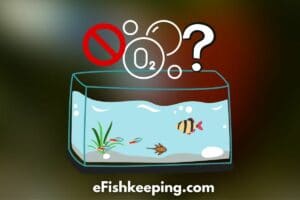So, you feel that your tank lacks activity, huh? Or maybe you go to your local fish shop and you find a good deal on fish, and so you think about getting more fish.
You might have just bought a new tank and you can’t wait to fill it up with your favorite kinds of fish! These scenarios make you wonder, how many fish can I add at once to my tank?
Let’s find out!
How Many Fish Can I Add to My Aquarium at Once?
You can add 2-3 fish at once to your aquarium, then you have to wait for a week and test the levels of ammonia and nitrite in your tank.
If their levels are zero, that’s your green light to add another round of 2-3 fish and repeat the process until you reach the maximum capacity of your tank.
What Is the Maximum Number of Fish to Add to My Aquarium?
The answer to this question is complicated. To simplify things, your fish need a certain oxygen level, a suitable temperature range, clean water, and adequate space to be healthy and happy.
If you overfill your tank, the fish will overload the tank with waste, going over the ability of the living bacteria to break it down, which can endanger your fish.
It’s also worth noting that adding too many fish will mean that your fish will have less space to swim, which can be detrimental to their wellbeing.
The general rule is 1 inch of fish per 1-2 gallons of water.
With that in mind, the number of fish in your aquarium depends on the aquarium’s volume and the size of fish you want to put in it.
For example, if your tank has a capacity of 5 gallons, it can contain about 4-6 fish, each of them about an inch long.
As simple as that may sound, it’s a complicated calculation, as not all fish are the same size and you have to deduct the decorations and equipment in the aquarium from the total volume of the tank.
If this is overwhelming to you, you can use a fish stock calculator. You just need to know your tank’s length and width to calculate the volume.
How Many New Fish Can I Add at a Time to My Aquarium?
Many factors can influence the number of fish that you can add at a time, including:
- Tank size and surface area
- Existing stock
- Fish size
- Nutrients
- Filtration
- Waste products
Taking those factors into consideration, it’s advised that you add no more than 2-3 fish at a time. Adding a lot of fish can disturb the ecosystem and cause much stress to your existing stock.
How Many Fish Can I Add to a Cycled Tank?
The nitrogen cycle inside your aquarium is complicated. A big change in that cycle can mess everything up, so it’s extremely important to be patient!
To keep it simple, you can add as many fish as you want, as long as it doesn’t interfere with the balance of the ecosystem.
However, there’s no simple way to know the limit that keeps your fish safe. So, if you’re not an expert, it’s advised to not add more than 3-4 fish at a time. It’s better to be safe than sorry!
What Happens If I Put Too Many Fish at Once?
Adding too many fish can disrupt the balance inside your tank! It’s advised to keep testing that water for ammonia and nitrite levels after adding a big stock of fish.
If your test results are higher than zero after adding your fish, that means you added too many fish and the nitrogen cycle isn’t working right.
This could be a threat to the fish in your tank and you’d need to act immediately.
What to Do When Ammonia and Nitrite Levels Become High?
You’ll need to stop adding fish and fish food, and start controlling the levels of waste products by following these steps:
- Do a partial 25% to 50% water change
- Get rid of uneaten food
- Use a water conditioner
- Remove any dead plants
- Look for any dead fish and remove them
- Make sure your filter is working properly and isn’t clogged
If the ammonia levels remain high, keep doing partial water changes until it goes back to zero.
Read: Do Ammonia Sand Cause Ammonia Spike?
What Are the Signs of Ammonia Toxicity in Fish?
Ammonia and nitrite waste are fatal to your fish, so you must always keep an eye out for any of the following signs:

- Fish floating close to the surface, gasping for air
- Lack of activity and staying at the bottom of the tank
- Decreased appetite
- Inflamed eyes or gills
- Red flecks on the fish’s skin
If you notice any of these signs, immediately test for ammonia and nitrite levels, and follow the previous steps as soon as possible to save your fish!
How to Avoid Increasing Ammonia and Nitrite Levels?
Scheduled water testing can prevent potential damage from happening. To avoid ammonia and nitrate accumulation, follow these precautions:
- Make sure your tank isn’t over-populated
- Don’t overfeed your fish
- Clean the tank regularly
- Make sure that the filtration system is always working properly
- Perform regular maintenance and water testing
If Levels Are Back to Zero, Can You Add More Fish?
The spike in ammonia and nitrite levels meant that the nitrogen cycle wasn’t performed properly. Adding more fish depends on the reason for the spike.
If it was due to bad filtration, overfeeding, or not cleaning the tank, fixing the problem can allow you to add more fish.
However, if it was due to overstocking your tank, you can’t add any more fish.
How to Introduce the Fish to Their New Home?
Moving pets to new homes can be a stressful experience for them. Fish struggle even more so than other pets as they’re not only introduced to a new home, but the environment in that home is completely different from theirs.
They’ll be moving into water that has different pH levels and temperatures, as well as solid components. This can be a difficult experience for your fish if you don’t prepare them for it.
Acclimating your fish to the new tank isn’t a hard task, though. You just need to be patient and follow these steps:
- Let the sealed bag of fish float in the tank for 20 to 30 minutes
- Unseal the bag, and add half a cup of water from your aquarium into the bag
- Reseal the bag and let it float again in the aquarium for 10 minutes
- Repeat the second step until the bag is filled with aquarium water
- Scoop your fish one by one from the bag and carefully place them into your aquarium
It’s recommended that you dim the lights in the room and inside the aquarium for a few hours to let your little friends rest from the stressful process.
Test the water every 2 hours to make sure everything is alright. I recommend regularly testing the water for the following:
- pH
- Chlorine
- Ammonia
- Nitrite
- Nitrate
- Alkalinity
- Phosphate
If your tank already has residents, it’s best if you feed them before introducing new fish to them. This will reduce the amount of tension and aggression.
How to Add Multiple Fish at Once to the Tank?
You can follow the same steps from the previous section to add multiple fish to your tank.
It’s recommended to do it in batches that consist of 2-4 fish at a time, wait for a week, and test the water before adding another batch.
If you want to add more than four fish at once, you must keep in mind that it’s risky and can cause harm to your fish and make them more susceptible to illness.
If you’re willing to add five or more fish at once, you should consider adding live bacteria to your tank to help get rid of the excess waste, as the existing bacteria may not be enough to keep the balance.
Afterward, keep testing the water every couple of hours and make sure the ammonia and nitrite levels are not rising.
In Summary
Adding fish to your aquarium requires patience and good observation. The process needs time to be done right, and speeding up the process may harm your fish.
Calculate your tank capacity before adding any fish, and never overstock your tank as it can be fatal to your fish.
It’s not recommended to add more than 2-3 fish at once. Let them settle in for a week, then test the ammonia levels in the water before adding more fish.
Ammonia and nitrite can kill your fish, so always make sure their levels are zero by maintaining scheduled water tests. If you see any signs of ammonia toxicity, adjust your water immediately.
Hi! I’m Praveen Ghoshal, the founder of eFishkeeping.com. Inspired by my Dad, I got interested in fishkeeping when I was a kid. Since then, I have been involved with this hobby. Currently, I have 3 fish tanks at our home, and I enjoy this hobby with my full family. Read more about me here.







